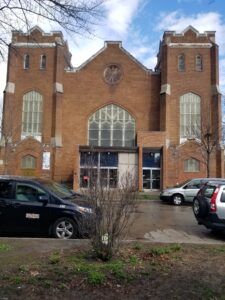BY SUE KOLSTAD
Seward faces the possible demolition of Bethany Lutheran Church at 2511 E. Franklin Ave. Augsburg University, the building’s owner, announced in March an agreement to sell the former Bethany Lutheran Church property to the Somali Museum of Minnesota to develop a permanent museum facility and cultural center on the site. Neighborhood residents are concerned at the prospect of demolishing the historic building that has meant so much to them. Many others are unaware of the plans for demolition.
 (See https://southsidepride.com/2021/09/20/bethany-lutheran-church-closed-sept-12/ for a history of the church.)
(See https://southsidepride.com/2021/09/20/bethany-lutheran-church-closed-sept-12/ for a history of the church.)
On April 27, a gathering was held at Matthews Recreation Center to inform neighbors about the plans. About 60 people attended to hear a detailed history of the church going back a hundred years. This was followed by a presentation by Augsburg University explaining the process that went into acquiring the property and their decision that the best plan is for a purchaser to demolish the building and build anew. The group then broke up into small groups to share their stories about the church and to ask questions. That information will be shared with the people at the Somali Museum but was shared only in a limited way at the gathering.
Bethany Church was donated to Augsburg in May 2020. The space has been used over time by many social service organizations, among them Soup For You! Cafe, a daycare, Centro de Trabajadores Unidos en la Lucha (CTUL), CAIR, Freedom Fighters, Overeaters and Alcoholics Anonymous, a gay and lesbian elders group, an herbalist guild, and a Quaker worship meeting.
Redesign Inc., a Seward community-based developer, has made a feasibility study focused on three possible options:
Renovation: This would require an ADA kitchen and restrooms brought up to code, as well as taking care of deferred maintenance, lighting and finishes on both exterior and interior, at an estimated cost of $3.8 million plus the acquisition cost of the building. This would bring in an estimated net income of $131,000 per year.
Adaptive use: This would involve demolition and rebuilding of the education wing, and renovating the sanctuary to serve as flexible space and low-income housing using tax credits and MHFA loans. The estimated cost would be $18.7 million for construction and investment plus the acquisition cost. Estimated net income for this option would be $407,000 per year.
Ground-up (demolition and new construction): Mixed use, housing, community-focused commercial or cultural, estimated at $33.9 million construction plus acquisition costs, bringing in a net income of $1,016,000 per year.
Details about how the above numbers were calculated were not available, nor was the acquisition cost.
Augsburg negotiated with the Somali Museum and came up with an agreement to sell, with the museum demolishing the building. There is a preliminary plan for new construction of a four-story building plus a 42-spot parking garage. The Somali Museum was located at Bloomington and Lake until recently, when it moved to the basement at Midtown Global Market as a temporary location until they are able to find enough space for their programming and artifacts. This sale does not seem to fall under the three categories examined by Redesign.
A concern raised at the gathering is about the prospect of demolishing the historic building. Two community members who are experts in historic preservation were consulted earlier by the group concerned about the proposed demolition.
Bob Mack suggested two things: 1. Convince the new owners that it’s quicker and far less expensive to work with an existing building than it is to start over. (Think about the Museum of Russian art in the former Mayflower Church building.); and 2. Appeal to their environmental concerns. The building already has embodied energy that would be lost if the building is demolished.
Bob Roscoe said, “I consider Bethany Lutheran Church to serve Seward neighborhood and the local built environment as a worthy place giving grace and cultural meaning to its immediate location, the neighborhood and Minneapolis. Its prominent location serves our collective sense of culture as we pass by. The structure is in good condition and seems to await its rescue.
“I have served on the Minneapolis Preservation Commission for 21 years, twice as chairperson. I was one of the founders of the Preservation Alliance of Minnesota (now Rethos). My architectural practice, recently concluded, involved the architectural rescue and appropriate economic reuse of many historic structures. … Also, I have written three books on Minnesota and regional preservation, with another in process. We continually observe our urban environment offering structures and landscapes worthy of protection and development for our public appreciation.”
One might consider that it is appropriate to develop a new community (represented by the Somali Museum) within a Scandinavian community space (the historic church) to represent that the groups live and work together in the larger neighborhood with mutual respect.
The people of Seward still celebrate the activists who banded together to save the entire community from redevelopment that would have resulted in the demolition of many homes and buildings. The Milwaukee Avenue historic pedestrian mall is the result of that. There is a new group forming to address the demolition of the Bethany Lutheran Church building.
























